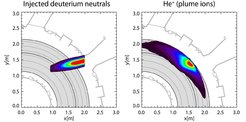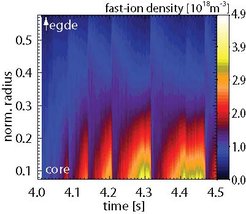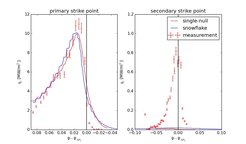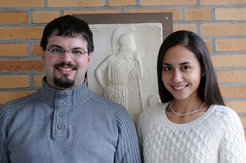Highlights 2014
Research news from the division Plasma Edge and Wall



Snowflake divertor

Presently the most promising design for a fusion reactor is the divertor Tokamak in `single-null' configuration. The heat produced in the central plasma is guided by the divertor legs to the divertor target plates. A big problem is the strong localization of these fluxes that bring the target materials to their heat load limits. The `snowflake divertor', a configuration with two additional divertor legs, is presently discussed as a concept to distribute the heat flux over a larger area. Due to its more complicated topology, however, is was only marginally possible so far to describe this configuration numerically.
In collaboration with the swiss experiment TCV, where this configuration is studied experimentally, the first calculations with EMC3-Eirene, a code developed at IPP, were carried out successfully. It was found that the heat transport to the secondary divertor legs is actually significantly larger than predicted by common models. However, in absolute numbers this effect is of the order of ~10 % only in TCV. Whether this effect becomes larger in a larger device and whether the configuration is suitable for a reactor is a matter of further investigations. This article was published by the journal `Plasma Physics and Controlled Fusion' as an `IOP select'-article:
T. Lunt et al. 2014 Plasma Phys. Control. Fusion 56 035009
Linear stability analysis of ELMs at ASDEX Upgrade – A. Burckhart
Edge localized modes (ELMs) are magnetohydrodynamic instabilities that occur at the edge of magnetically confined fusion plasmas. They periodically expel particles and energy from the confined region. In addition to limiting the confinement, they cause high heat fluxes to the walls of the tokamak which may not be manageable in larger, next-generation devices. However, the exact nature of the instabilities that drive ELMs is still unknown. The most commonly invoked theory to explain the occurrence of ELMs is the peeling-ballooning model which posits a critical edge pressure gradient and current density.
In his PhD thesis ‘Different ELM regimes at ASDEX Upgrade and their linear stability analysis’ Andreas Burckhart investigated whether the peeling-ballooning model can explain the occurrence of ELMs. One example is shown below.

ELMs can be influenced by depositing localized ECRH power at the plasma edge. It was shown at TCV that the ELM frequency increases and the per-ELM losses decrease when shifting the power deposition to the edge [Rossel et al, Nucl. Fusion 2012]. At ASDEX Upgrade, however, a different behavior is observed. Rather than the ELM frequency increasing, a second, higher frequency band formes and becomes more populated as more power is moved to the edge. A peeling-ballooning analysis of the profiles shows that the core-heated reference plasma is marginally unstable, while it is stabilized when shifting the power to the edge. This is mainly due to a relaxation of the kinetic profiles while the stability boundary stays the same. One can speculate that ECRH drives turbulence at the deposition location, thereby enhancing transport and limiting the pedestal top and gradients, which prevents the plasma from reaching the peeling-ballooning stability limit. Since the relaxation of the gradients does not suppress the ELMs but, on the contrary, increases their frequency, this is an indication that peeling-ballooning theory is missing a key ingredient to explain the ELM trigger.

Two E2M Postdocs win a Fusion Research Fellowship
Two post-doctoral candidates from E2M successfully applied for a Fusion Research Fellowship. Dr. Eleonora Viezzer and Dr. Armin Manhard are among the 17 candidates from all over Europe who were awarded a fellowship in December 2013.
Dr. Eleonora Viezzer started working for her Diploma thesis in IPP in late 2008 and continued with her PhD project in 2010. She graduated at the Ludwig-Maximilian University Munich in February 2013. The title of her thesis is “Radial Electric Field Studies in the Plasma Edge of ASDEX Upgrade”.
Dr. Armin Manhard started in IPP with his Diploma thesis in 2007. In 2008 he began his PhD project entitled: “Deuterium Inventory in Tungsten after Plasma Exposure: A Microstructural Survey”. He graduated at the University Augsburg in May 2012.
We congratulate Dr. Viezzer and Dr. Manhard and wish them great success for realization of their project objectives. A short description of their project proposals:
Eleonora Viezzer
Impact of poloidal impurity asymmetries on edge current and pedestal stability
The improvement and maintenance of plasma performance on a steady-state and economical basis is a key issue for the development of future fusion power plants. At present, the highest attainable pressure is achieved in the high-confinement regime (H-mode), which is characterized by the formation of an edge transport barrier. The stability of this barrier is thought to be driven by a complex interplay between the edge current j and the pressure gradient ∇p. In order to test current pedestal stability theories, the profile shape and the magnitude of both j and ∇p are required at a high level of accuracy with a temporal (spatial) resolution on the ms (mm) range. However, accurate measurements of j are challenging due to the complicated nature of the measurement.
Combined with the unique edge diagnostic suite available at AUG, the research project aims at the accurate measurement of j and ∇p to gain a solid understanding of the dynamics between the current density and pressure gradient in the edge transport barrier. In addition, the impact of impurities on the edge current and stability of the H-mode pedestal will be studied by means of an integrated approach based on experimental measurements combined with theoretical tools.
Armin Manhard
Influence of Different Defect Types on Hydrogen Isotope Transport and Retention in Tungsten
Hydrogen can barely be dissolved in a perfect tungsten crystal, but hydrogen atoms that actually make it into the material can diffuse through it quickly. Defects such as dislocations, grain boundaries and vacancies can strongly alter the behaviour of hydrogen in tungsten. They can trap hydrogen atoms, thus increasing retention and slowing down the effective diffusion. But there is also indication that, e.g., grain boundaries may serve as diffusion highways. In this project, the creation of defects by exposure of tungsten to hydrogen plasmas will be investigated by electron microscopy and ion beam analysis. In addition, diffusion of hydrogen in tungsten will be measured with an electrochemical double cell. This newly constructed set-up allows highly sensitive measurements near room temperature, where up to now only very few data are available.





